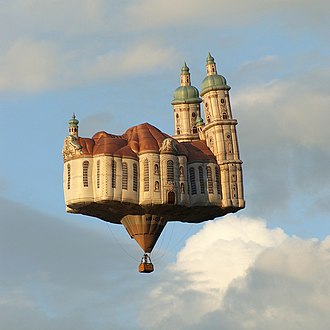Hot air balloon





Hot air balloon is a type of lighter-than-air aircraft that is propelled and lifted by heating the air inside the balloon. It is the oldest successful human-carrying flight technology, with the first untethered manned flight made by Jean-François Pilâtre de Rozier and François Laurent d'Arlandes in Paris, France, on November 21, 1783, in a balloon created by the Montgolfier brothers.
History[edit]
The concept of the hot air balloon dates back to the 3rd century BC in China, where Zhuge Liang used airborne lanterns for military signaling. These lanterns are now known as Kongming lanterns. However, the first recorded manned flight was not until the Montgolfier brothers' demonstration in 1783.
Design and Operation[edit]
A hot air balloon consists of three main parts: the envelope, which contains the heated air; the burner, which heats the air; and the basket, which carries the passengers and the source of heat. The envelope is usually made from nylon or polyester, materials that are lightweight yet strong enough to contain the hot air. The burner uses propane as fuel to heat the air inside the envelope, causing the balloon to rise. The pilot can control the altitude of the balloon by adjusting the temperature of the air inside the envelope.
Physics[edit]
The principle that allows a hot air balloon to float is the same principle that explains why objects float in water: Archimedes' principle. In the case of a hot air balloon, the heated air inside the envelope has a lower density than the cooler air outside, creating an upward buoyant force that can lift the balloon and its payload.
Types of Hot Air Balloons[edit]
There are several types of hot air balloons, including traditional balloons, rozier balloons (a combination of hot air and gas), and solar balloons which are heated by the sun. The traditional hot air balloon is the most common type used for recreational and competitive flying.
Uses[edit]
Hot air balloons are used for a variety of purposes, including recreational flights, competitive events like races and distance records, advertising, and scientific research. Balloon festivals are popular events worldwide, attracting enthusiasts and tourists.
Safety[edit]
While hot air ballooning is generally safe, accidents can occur. The most common risks involve collisions with power lines, trees, and other obstacles. Weather conditions play a significant role in flight safety, and pilots must be trained to understand and react to changing weather patterns.
Regulation[edit]
In many countries, hot air balloons are regulated by aviation authorities. Pilots must obtain a license, and balloons must be inspected and certified as airworthy. Regulations vary by country, but they typically include standards for operation, maintenance, and pilot certification.
Cultural Impact[edit]
Hot air balloons have a significant cultural impact, symbolizing freedom, adventure, and the spirit of exploration. They are featured in literature, films, and art, capturing the imagination of people around the world.
Ad. Transform your life with W8MD's Budget GLP-1 injections from $75


W8MD offers a medical weight loss program to lose weight in Philadelphia. Our physician-supervised medical weight loss provides:
- Weight loss injections in NYC (generic and brand names):
- Zepbound / Mounjaro, Wegovy / Ozempic, Saxenda
- Most insurances accepted or discounted self-pay rates. We will obtain insurance prior authorizations if needed.
- Generic GLP1 weight loss injections from $75 for the starting dose.
- Also offer prescription weight loss medications including Phentermine, Qsymia, Diethylpropion, Contrave etc.
NYC weight loss doctor appointmentsNYC weight loss doctor appointments
Start your NYC weight loss journey today at our NYC medical weight loss and Philadelphia medical weight loss clinics.
- Call 718-946-5500 to lose weight in NYC or for medical weight loss in Philadelphia 215-676-2334.
- Tags:NYC medical weight loss, Philadelphia lose weight Zepbound NYC, Budget GLP1 weight loss injections, Wegovy Philadelphia, Wegovy NYC, Philadelphia medical weight loss, Brookly weight loss and Wegovy NYC
|
WikiMD's Wellness Encyclopedia |
| Let Food Be Thy Medicine Medicine Thy Food - Hippocrates |
Medical Disclaimer: WikiMD is not a substitute for professional medical advice. The information on WikiMD is provided as an information resource only, may be incorrect, outdated or misleading, and is not to be used or relied on for any diagnostic or treatment purposes. Please consult your health care provider before making any healthcare decisions or for guidance about a specific medical condition. WikiMD expressly disclaims responsibility, and shall have no liability, for any damages, loss, injury, or liability whatsoever suffered as a result of your reliance on the information contained in this site. By visiting this site you agree to the foregoing terms and conditions, which may from time to time be changed or supplemented by WikiMD. If you do not agree to the foregoing terms and conditions, you should not enter or use this site. See full disclaimer.
Credits:Most images are courtesy of Wikimedia commons, and templates, categories Wikipedia, licensed under CC BY SA or similar.
Translate this page: - East Asian
中文,
日本,
한국어,
South Asian
हिन्दी,
தமிழ்,
తెలుగు,
Urdu,
ಕನ್ನಡ,
Southeast Asian
Indonesian,
Vietnamese,
Thai,
မြန်မာဘာသာ,
বাংলা
European
español,
Deutsch,
français,
Greek,
português do Brasil,
polski,
română,
русский,
Nederlands,
norsk,
svenska,
suomi,
Italian
Middle Eastern & African
عربى,
Turkish,
Persian,
Hebrew,
Afrikaans,
isiZulu,
Kiswahili,
Other
Bulgarian,
Hungarian,
Czech,
Swedish,
മലയാളം,
मराठी,
ਪੰਜਾਬੀ,
ગુજરાતી,
Portuguese,
Ukrainian
